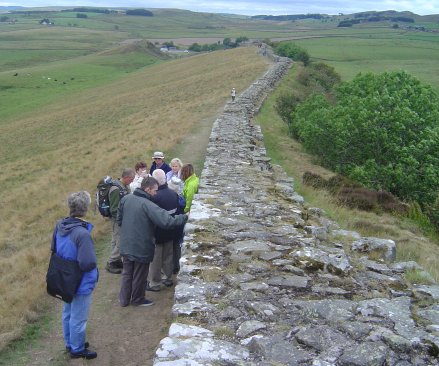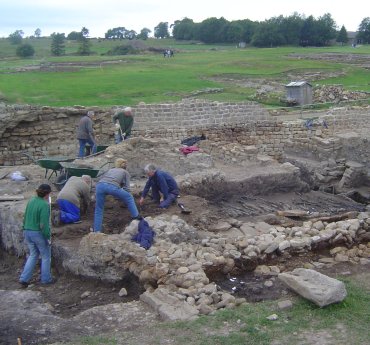 Last
month's society trip went off without a hitch (apart from the traditional
technical problems with the coach - this year it was a leaky radiator).
Our first stop was a section of Hadrian's Wall at Cawfield Crags near
Haltwhistle. This is a particularly good section with a well-preserved
milecastle and a long and straight section of Vallum on show. The width of
the wall here is generally 8 feet wide (suggesting an original height of
15 feet) but further east it's 10 feet. This came about due to a change of
plan by the Romans mid way through construction (in some areas you can see
the transition where the foundations are still at the original width). Last
month's society trip went off without a hitch (apart from the traditional
technical problems with the coach - this year it was a leaky radiator).
Our first stop was a section of Hadrian's Wall at Cawfield Crags near
Haltwhistle. This is a particularly good section with a well-preserved
milecastle and a long and straight section of Vallum on show. The width of
the wall here is generally 8 feet wide (suggesting an original height of
15 feet) but further east it's 10 feet. This came about due to a change of
plan by the Romans mid way through construction (in some areas you can see
the transition where the foundations are still at the original width).
Just to clear up some confusion, the wall, as we see it today, is real.
The only reconstruction has been carried out to consolidation it -
achieved, in the words of English Heritage, by removing lose stones down
to the original Roman mortar, and replacing with originals.
Having had a really hot summer, the weather managed to conspire against us
and, although it didn't rain, a chill wind meant nobody wanted to stay out
on the exposed crags too long. Most, however, managed to walk a good
distance along the wall, before returning to the coach for the short hop
to our final destination - the Roman fort of Vindolanda.
The first time we visited this site was in the early days of the society
(in the mid 80's). Since then there have been numerous discoveries; -
stone roundhouses, sections of collapsed fort wall (abandoned and built
over), and a second bathhouse, to name just a few. Due to the unique soil
conditions, the most remarkable has been the organic material - in
particular the wooden writing tables, which has given us a unique insight
into the everyday life on the edge of Empire.
We arrived on-site in plenty time to attend a fascinating talk by one of
the volunteer workers (a guy from Boston USA) who gave us more insight
into the site's development and all the discoveries to date. One of the
most remarkable, he explained, has been a huge cache of leather shoes
(1500 in all - the closest anywhere else in the Empire is 4 from Holland).
The talk was given as excavations continued (they even work on Sundays)
and anybody can join the excavation team as long as they book early enough
(see their website for details
www.vindolanda.org.uk ).
 Another
amazing discovery is a series of earlier forts underlying the one we see
today. One of these is so big they haven't been able to determine its full
extent yet, despite acquiring more and more land from adjacent farmland. Another
amazing discovery is a series of earlier forts underlying the one we see
today. One of these is so big they haven't been able to determine its full
extent yet, despite acquiring more and more land from adjacent farmland.
Vindolanda is a great site with a fascinating museum (I could have stayed
all day) but the cold conditions persuaded most not to linger and it
wasn't too long before we were all back on the coach reflecting on another
great society trip.Jacobite Invasion
This is the title of a study day at Lancaster University's Centre for
North-West Regional Studies to be held on Saturday 14th October.
The fee is £16 including tea and coffee. More details at the meeting.
Archaeology For All
This is a full week-end conference being run by The University of
Manchester. Although billed as a national conference it has an
international flavour, with speakers presenting from all around the world.
Over 2 days, the conference will explore the theory and practice of
Community Archaeology. Guest speakers include David Lammy MP - Minister
for Culture, Mike Heyworth, -director of the CBA and Julian Richards from
"Meet the Ancestors". The dates are Saturday and Sunday 3rd and 4th
November and (for society members) will cost a very reasonable £10 a day.
Next WAS Meeting
Wednesday 6h September at the District Scout HQ (Baden Powell Centre)
in Greenough Street, starting at 7.30 pm as usual. This month we have
Rachel Newman from Oxford Archaeology North who will be telling us about
all their recent activities (including more details of the Roman Tombstone
found earlier this year on the outskirts of Lancaster (see Newsletter 90).
Hope to see you there. B.A.
|



